
myCBSEguide App
Download the app to get CBSE Sample Papers 2023-24, NCERT Solutions (Revised), Most Important Questions, Previous Year Question Bank, Mock Tests, and Detailed Notes.
Install NowExtra Questions for Class 12 Biology Sexual Reproduction in Flowering Plants. myCBSEguide has just released Chapter Wise Question Answers for class 12 Biology. There chapter wise Test papers with complete solutions are available for download in myCBSEguide website and mobile app. These Extra Questions with solution are prepared by our team of expert teachers who are teaching grade in CBSE schools for years. There are around 4-5 set of solved Biology Extra questions from each and every chapter. The students will not miss any concept in these Chapter wise question that are specially designed to tackle Board Exam. We have taken care of every single concept given in CBSE Class 12 Biology syllabus and questions are framed as per the latest marking scheme and blue print issued by CBSE for Class 12.
CBSE Class 12 Biology Ch – 2 Practice Test
Test Paper for Class 12 Biology Sexual Reproduction in Flowering Plants
Ch-2 Sexual Reproduction in Flowering Plants
- Anther is a four sided structure consisting of four
- Theca
- Microsporangia
- Pollen grains
- Mega sporangia
- Statement I: Seed is the basis of agriculture.
Statement II: Dehydration and dormancy of mature seed is crucial for storage of seeds.
Statement III: Seeds of rice and wheat remain viable for several years at normal condition.- Statements I and III are correct
- All statements are correct
- Statements I and II are correct
- Statements II and III are correct
- Assertion: Ovule develops into mature seeds and ovary develops into fruits.
Reason: The fruits that develop only from ovary are called true fruits.- Both assertion and reason are correct
- Assertion and reason both are incorrect
- Assertion is incorrect but reason is correct
- Assertion is correct but reason is incorrect
- Which of the following plant is not pollinated by water?
- Lotus
- Vallisneria
- Zostera
- Hydrilla
- Wind and water pollinated flowers are not very colorful and do not produce nectar because
- They are not pollinated by biotic factors
- Colour is not necessary for attention of bees
- Insects are not to be attracted
- Their colour has been fade up
- Can an unfertilised, apomictic embryo sac give rise to a diploid embryo? If yes, then how?
- If the chromosome number of a plant species is 20, what would be the chromosome number in its: (i) Pollen grains (ii) Endosperm cells?
- Write the name of structure only through pollen tube enters within the embryo sac.
- Write the name of condition in which pollen grains mature prior to stigma in bisexual reproduction.
- Identify the types of flower shown in A and B. Which out of the two will produce an assured seed set.
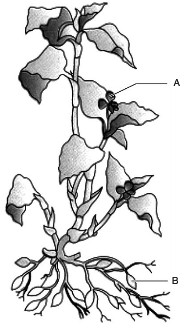
- How many haploid cells are present in a mature female gametophyte of a flowering plant? Name them.
- What is apomixes and what is its importance?
- Describe the structure of pollen grain and the process of its germination.
- With a neat diagram explain the 7-celled, 8-nucleate nature of the female gametophyte.
- What develops into a microspore mother cell in a flower? Trace the development of this cell into a pollen grain which is ready for germination. Draw a labelled figure by a mature pollen grain.
- Microsporangia, Explanation: The anther is a tetragonal structure consisting of four microsporangia located at the corners, two in each lobe. Microsporangium develops to form pollen sacs inside which pollen grains are formed.
- Statements I and II are correct, Explanation: Seed is the basis of agriculture. Before storage, seeds are dehydrated in sunlight. Seeds remain dormant till the favorable condition is present. Seeds of wheat and rice remain viable only few years.
- Both assertion and reason are correct, Explanation: Ovule develops to form seeds and mature ovary develops into fruits. The fruits that develop only from ovary are called true fruits and those who contain other parts of flower are called false fruits.
- Lotus, Explanation: Lotus is an aquatic plant but the flower of lotus is outside and above the water surface. So, it cannot be pollinated by water. It is generally pollinated by insects.
- Insects are not to be attracted, Explanation: Wind and water pollinated flowers are generally not colorful and not produce nectar. Colour and nectar of flowers are meant for attracting insects for pollination.
- Yes, if the embryo develops from the cells of nucellus or integument, it will be diploid as nucellus and iteguments are diploid.
- i. Pollen grains – 10, ii. Endosperm cell – 30
- Micropyle is minute opening in the ovule of a seed plant through which the pollen tube usually enters.
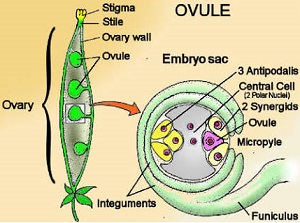
- Protandry is the condition in which an organism begins life as a male and then changes into a female. The condition of flowers whose male parts mature before the female ones.
- A – Chasmogamous flower, B – Cleistogamous flower
Cleistogamous flower produces assured seed set. - 7 cells – Antipodals (3), Secondary nucleus (1), Synergids (2), Egg cell (1)
- Apomixis is production of seeds without fertilization. Hybrid seeds can be cultivated with the help of apomixes. It is still at research stage, but if experiments are successful then it may help in increasing the yield of better variety of crops.
- Structure of Pollen grain:
Pollen grains are generally spherical and are about 25-50 micrometers in diameter. It has an outer layer exine and inner layer intine. Mature pollen grain contains a bigger vegetative cell and a smaller generative cell.
Germination of Pollen Grain: The process of development of pollen tube is called germination. Hydration of stigma results in elongation of tube cells into the pollen tube. Pollen tube then grows towards the ovule for further process. 
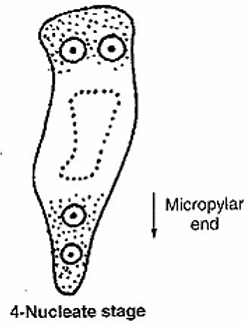
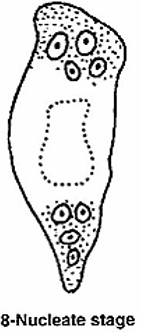
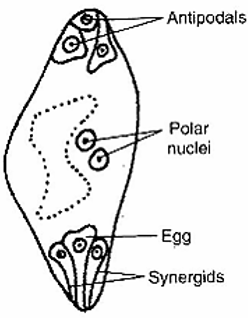
- Sporogenous cell divide and ultimately transformed into microspore mother cells. Microspore mother cells develop an internal layer of callose which breaks the plasmodesmal connections among themselves. The separated mother cells round off and undergo meiosis to produce tetrads of haploid microspores or pollen grains.
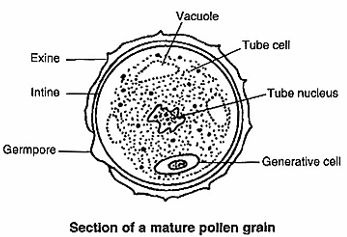
Class 12 Biology Chapter Wise Test Paper
- Reproduction in Organisms
- Sexual Reproduction in Flowering Plants
- Human Reproduction
- Reproductive Health
- Principles of Inheritance and Variation
- Molecular Basis of Inheritance
- Evolution
- Human Health and Disease
- Strategies for Enhancement in Food Production
- Microbes in Human Welfare
- Biotechnology Principles and Processes
- Biotechnology and its Applications
- Organisms and Populations
- Ecosystem
- Biodiversity and Conservation
- Environmental Issues

Test Generator
Create question paper PDF and online tests with your own name & logo in minutes.
Create Now
myCBSEguide
Question Bank, Mock Tests, Exam Papers, NCERT Solutions, Sample Papers, Notes
Install Now